engine overheat FIAT DOBLO COMBI 2018 Owner handbook (in English)
[x] Cancel search | Manufacturer: FIAT, Model Year: 2018, Model line: DOBLO COMBI, Model: FIAT DOBLO COMBI 2018Pages: 272, PDF Size: 23.75 MB
Page 53 of 272
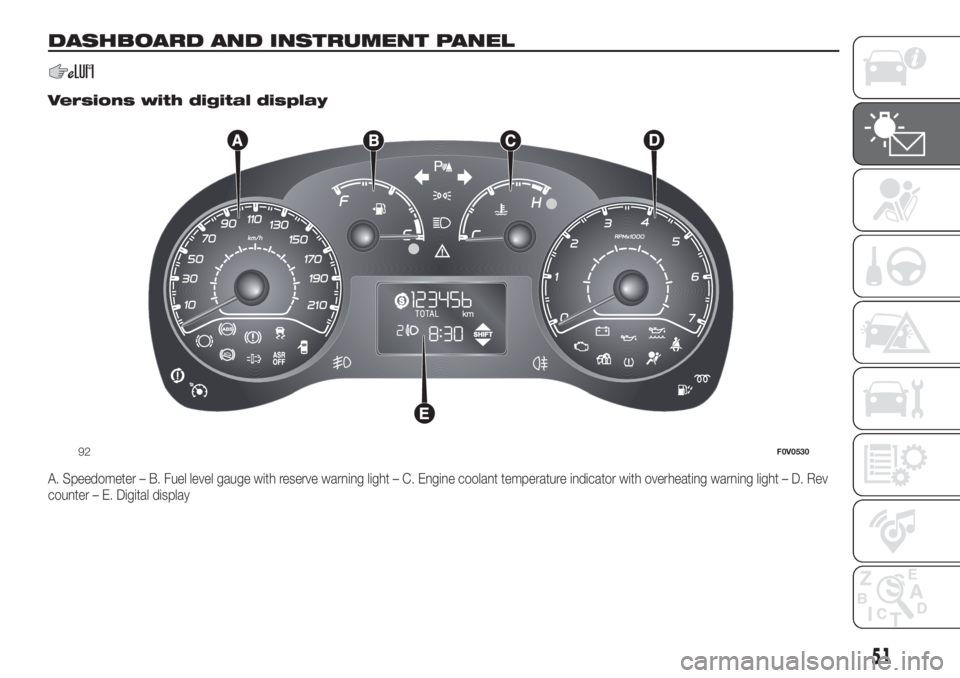
DASHBOARD AND INSTRUMENT PANEL
.
Versions with digital display
A. Speedometer – B. Fuel level gauge with reserve warning light – C. Engine coolant temperature indicator with overheating warning light – D. Rev
counter – E. Digital display
92F0V0530
51
Page 54 of 272
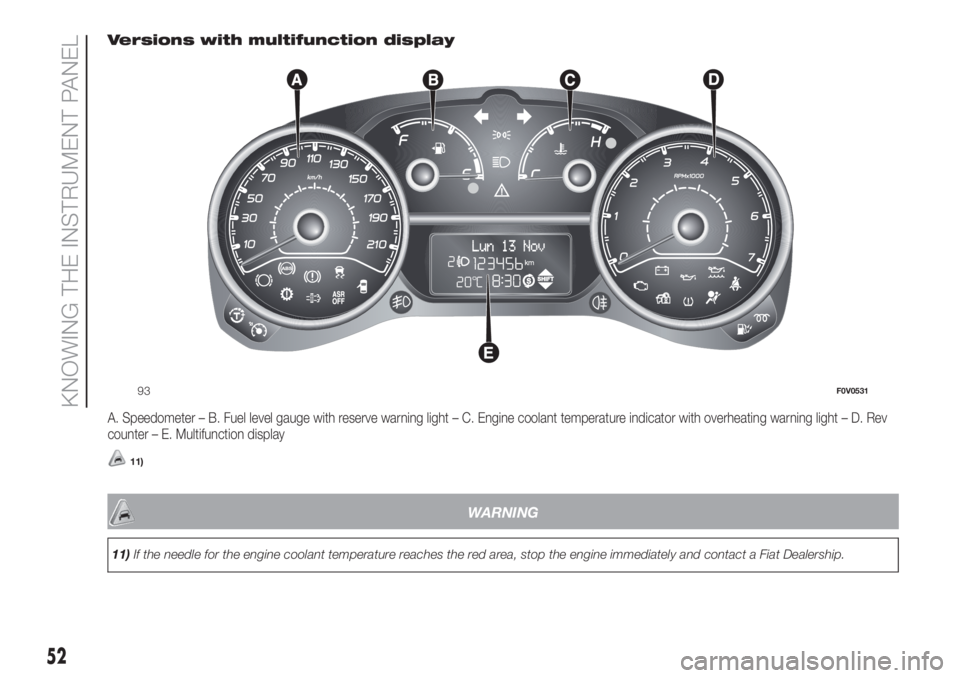
Versions with multifunction display
A. Speedometer – B. Fuel level gauge with reserve warning light – C. Engine coolant temperature indicator with overheating warning light – D. Rev
counter – E. Multifunction display
11)
WARNING
11)If the needle for the engine coolant temperature reaches the red area, stop the engine immediately and contact a Fiat Dealership.
93F0V0531
52
KNOWING THE INSTRUMENT PANEL
Page 61 of 272
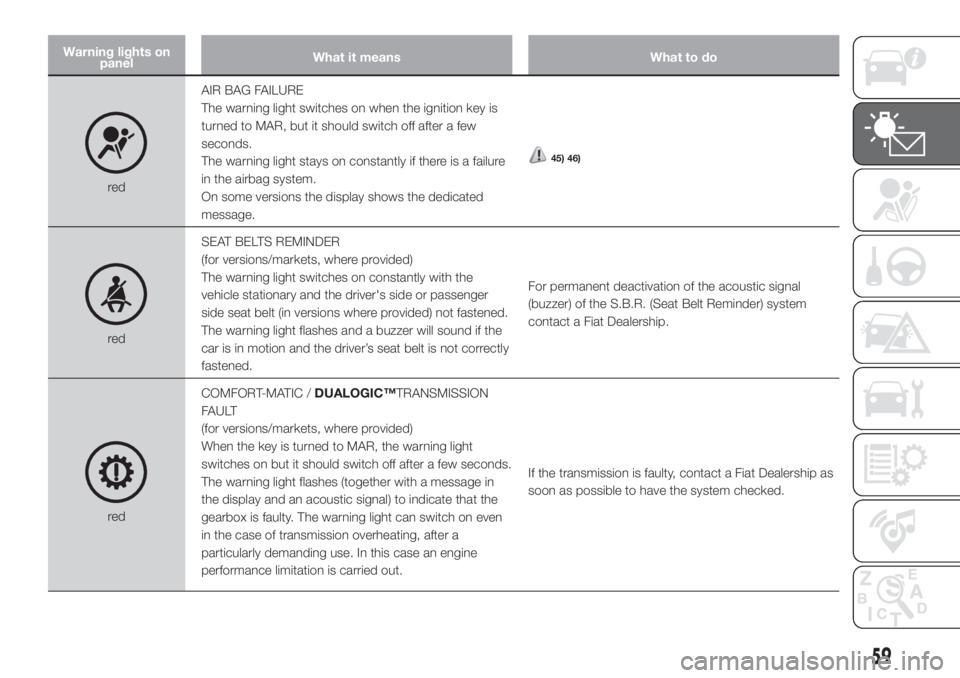
Warning lights on
panelWhat it means What to do
redAIR BAG FAILURE
The warning light switches on when the ignition key is
turned to MAR, but it should switch off after a few
seconds.
The warning light stays on constantly if there is a failure
in the airbag system.
On some versions the display shows the dedicated
message.
45) 46)
redSEAT BELTS REMINDER
(for versions/markets, where provided)
The warning light switches on constantly with the
vehicle stationary and the driver's side or passenger
side seat belt (in versions where provided) not fastened.
The warning light flashes and a buzzer will sound if the
car is in motion and the driver’s seat belt is not correctly
fastened.For permanent deactivation of the acoustic signal
(buzzer) of the S.B.R. (Seat Belt Reminder) system
contact a Fiat Dealership.
redCOMFORT-MATIC /DUALOGIC™TRANSMISSION
FAULT
(for versions/markets, where provided)
When the key is turned to MAR, the warning light
switches on but it should switch off after a few seconds.
The warning light flashes (together with a message in
the display and an acoustic signal) to indicate that the
gearbox is faulty. The warning light can switch on even
in the case of transmission overheating, after a
particularly demanding use. In this case an engine
performance limitation is carried out.If the transmission is faulty, contact a Fiat Dealership as
soon as possible to have the system checked.
59
Page 62 of 272
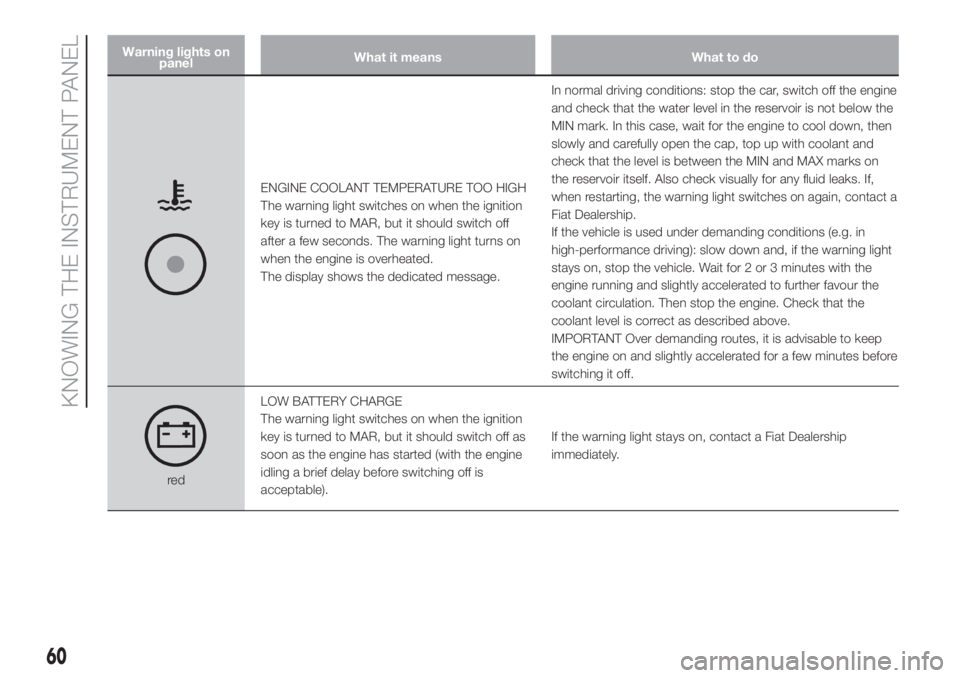
Warning lights on
panelWhat it means What to do
ENGINE COOLANT TEMPERATURE TOO HIGH
The warning light switches on when the ignition
key is turned to MAR, but it should switch off
after a few seconds. The warning light turns on
when the engine is overheated.
The display shows the dedicated message.In normal driving conditions: stop the car, switch off the engine
and check that the water level in the reservoir is not below the
MIN mark. In this case, wait for the engine to cool down, then
slowly and carefully open the cap, top up with coolant and
check that the level is between the MIN and MAX marks on
the reservoir itself. Also check visually for any fluid leaks. If,
when restarting, the warning light switches on again, contact a
Fiat Dealership.
If the vehicle is used under demanding conditions (e.g. in
high-performance driving): slow down and, if the warning light
stays on, stop the vehicle. Wait for 2 or 3 minutes with the
engine running and slightly accelerated to further favour the
coolant circulation. Then stop the engine. Check that the
coolant level is correct as described above.
IMPORTANT Over demanding routes, it is advisable to keep
the engine on and slightly accelerated for a few minutes before
switching it off.
redLOW BATTERY CHARGE
The warning light switches on when the ignition
key is turned to MAR, but it should switch off as
soon as the engine has started (with the engine
idling a brief delay before switching off is
acceptable).If the warning light stays on, contact a Fiat Dealership
immediately.
60
KNOWING THE INSTRUMENT PANEL
Page 108 of 272
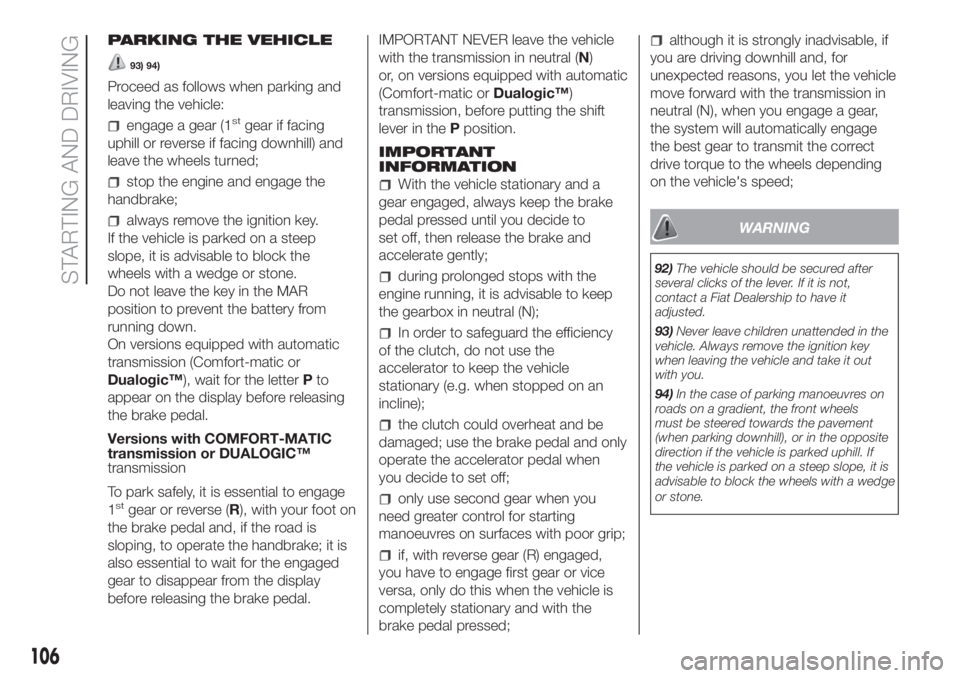
PARKING THE VEHICLE
93) 94)
Proceed as follows when parking and
leaving the vehicle:
engage a gear (1stgear if facing
uphill or reverse if facing downhill) and
leave the wheels turned;
stop the engine and engage the
handbrake;
always remove the ignition key.
If the vehicle is parked on a steep
slope, it is advisable to block the
wheels with a wedge or stone.
Do not leave the key in the MAR
position to prevent the battery from
running down.
On versions equipped with automatic
transmission (Comfort-matic or
Dualogic™), wait for the letterPto
appear on the display before releasing
the brake pedal.
Versions with COMFORT-MATIC
transmission or DUALOGIC™
transmission
To park safely, it is essential to engage
1
stgear or reverse (R), with your foot on
the brake pedal and, if the road is
sloping, to operate the handbrake; it is
also essential to wait for the engaged
gear to disappear from the display
before releasing the brake pedal.IMPORTANT NEVER leave the vehicle
with the transmission in neutral (N)
or, on versions equipped with automatic
(Comfort-matic orDualogic™)
transmission, before putting the shift
lever in thePposition.
IMPORTANT
INFORMATION
With the vehicle stationary and a
gear engaged, always keep the brake
pedal pressed until you decide to
set off, then release the brake and
accelerate gently;
during prolonged stops with the
engine running, it is advisable to keep
the gearbox in neutral (N);
In order to safeguard the efficiency
of the clutch, do not use the
accelerator to keep the vehicle
stationary (e.g. when stopped on an
incline);
the clutch could overheat and be
damaged; use the brake pedal and only
operate the accelerator pedal when
you decide to set off;
only use second gear when you
need greater control for starting
manoeuvres on surfaces with poor grip;
if, with reverse gear (R) engaged,
you have to engage first gear or vice
versa, only do this when the vehicle is
completely stationary and with the
brake pedal pressed;
although it is strongly inadvisable, if
you are driving downhill and, for
unexpected reasons, you let the vehicle
move forward with the transmission in
neutral (N), when you engage a gear,
the system will automatically engage
the best gear to transmit the correct
drive torque to the wheels depending
on the vehicle's speed;
WARNING
92)The vehicle should be secured after
several clicks of the lever. If it is not,
contact a Fiat Dealership to have it
adjusted.
93)Never leave children unattended in the
vehicle. Always remove the ignition key
when leaving the vehicle and take it out
with you.
94)In the case of parking manoeuvres on
roads on a gradient, the front wheels
must be steered towards the pavement
(when parking downhill), or in the opposite
direction if the vehicle is parked uphill. If
the vehicle is parked on a steep slope, it is
advisable to block the wheels with a wedge
or stone.
106
STARTING AND DRIVING
Page 110 of 272
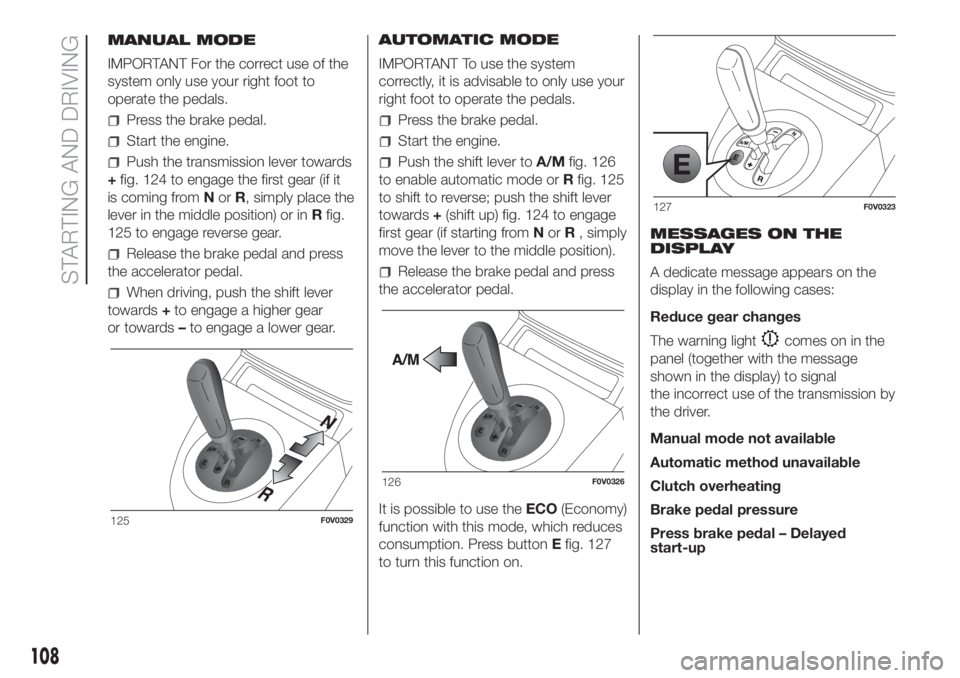
MANUAL MODE
IMPORTANT For the correct use of the
system only use your right foot to
operate the pedals.
Press the brake pedal.
Start the engine.
Push the transmission lever towards
+fig. 124 to engage the first gear (if it
is coming fromNorR, simply place the
lever in the middle position) or inRfig.
125 to engage reverse gear.
Release the brake pedal and press
the accelerator pedal.
When driving, push the shift lever
towards+to engage a higher gear
or towards–to engage a lower gear.AUTOMATIC MODE
IMPORTANT To use the system
correctly, it is advisable to only use your
right foot to operate the pedals.
Press the brake pedal.
Start the engine.
Push the shift lever toA/Mfig. 126
to enable automatic mode orRfig. 125
to shift to reverse; push the shift lever
towards+(shift up) fig. 124 to engage
first gear (if starting fromNorR, simply
move the lever to the middle position).
Release the brake pedal and press
the accelerator pedal.
It is possible to use theECO(Economy)
function with this mode, which reduces
consumption. Press buttonEfig. 127
to turn this function on.MESSAGES ON THE
DISPLAY
A dedicate message appears on the
display in the following cases:
Reduce gear changes
The warning light
comes on in the
panel (together with the message
shown in the display) to signal
the incorrect use of the transmission by
the driver.
Manual mode not available
Automatic method unavailable
Clutch overheating
Brake pedal pressure
Press brake pedal – Delayed
start-up
125F0V0329
126F0V0326
127F0V0323
108
STARTING AND DRIVING
Page 111 of 272
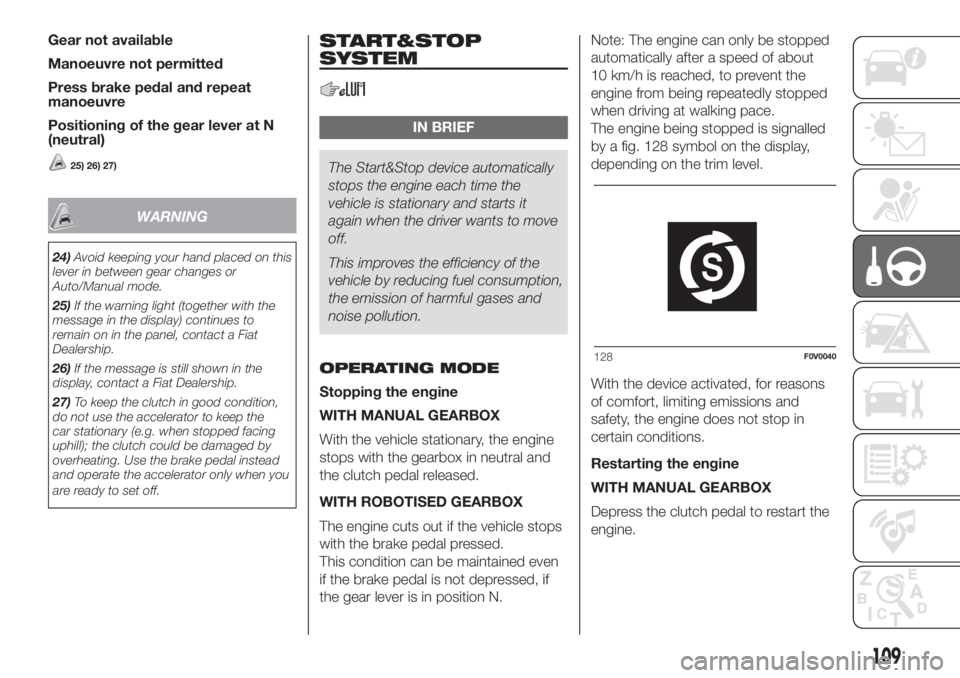
Gear not available
Manoeuvre not permitted
Press brake pedal and repeat
manoeuvre
Positioning of the gear lever at N
(neutral)
25) 26) 27)
WARNING
24)Avoid keeping your hand placed on this
lever in between gear changes or
Auto/Manual mode.
25)If the warning light (together with the
message in the display) continues to
remain on in the panel, contact a Fiat
Dealership.
26)If the message is still shown in the
display, contact a Fiat Dealership.
27)To keep the clutch in good condition,
do not use the accelerator to keep the
car stationary (e.g. when stopped facing
uphill); the clutch could be damaged by
overheating. Use the brake pedal instead
and operate the accelerator only when you
are ready to set off.
START&STOP
SYSTEM
IN BRIEF
The Start&Stop device automatically
stops the engine each time the
vehicle is stationary and starts it
again when the driver wants to move
off.
This improves the efficiency of the
vehicle by reducing fuel consumption,
the emission of harmful gases and
noise pollution.
OPERATING MODE
Stopping the engine
WITH MANUAL GEARBOX
With the vehicle stationary, the engine
stops with the gearbox in neutral and
the clutch pedal released.
WITH ROBOTISED GEARBOX
The engine cuts out if the vehicle stops
with the brake pedal pressed.
This condition can be maintained even
if the brake pedal is not depressed, if
the gear lever is in position N.Note: The engine can only be stopped
automatically after a speed of about
10 km/h is reached, to prevent the
engine from being repeatedly stopped
when driving at walking pace.
The engine being stopped is signalled
by a fig. 128 symbol on the display,
depending on the trim level.
With the device activated, for reasons
of comfort, limiting emissions and
safety, the engine does not stop in
certain conditions.
Restarting the engine
WITH MANUAL GEARBOX
Depress the clutch pedal to restart the
engine.
128F0V0040
109
Page 114 of 272
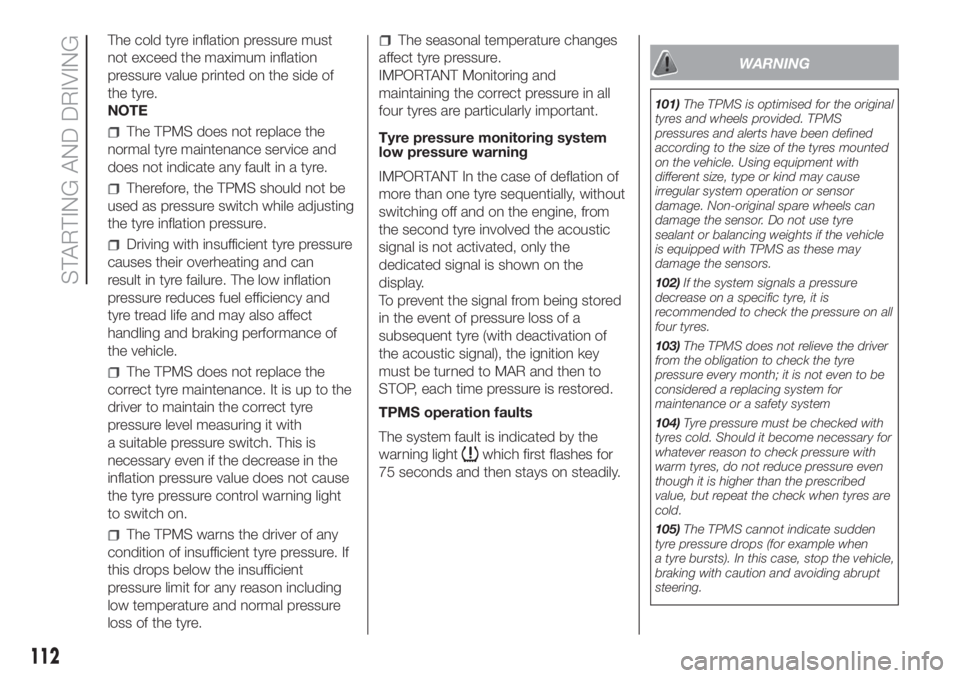
The cold tyre inflation pressure must
not exceed the maximum inflation
pressure value printed on the side of
the tyre.
NOTE
The TPMS does not replace the
normal tyre maintenance service and
does not indicate any fault in a tyre.
Therefore, the TPMS should not be
used as pressure switch while adjusting
the tyre inflation pressure.
Driving with insufficient tyre pressure
causes their overheating and can
result in tyre failure. The low inflation
pressure reduces fuel efficiency and
tyre tread life and may also affect
handling and braking performance of
the vehicle.
The TPMS does not replace the
correct tyre maintenance. It is up to the
driver to maintain the correct tyre
pressure level measuring it with
a suitable pressure switch. This is
necessary even if the decrease in the
inflation pressure value does not cause
the tyre pressure control warning light
to switch on.
The TPMS warns the driver of any
condition of insufficient tyre pressure. If
this drops below the insufficient
pressure limit for any reason including
low temperature and normal pressure
loss of the tyre.
The seasonal temperature changes
affect tyre pressure.
IMPORTANT Monitoring and
maintaining the correct pressure in all
four tyres are particularly important.
Tyre pressure monitoring system
low pressure warning
IMPORTANT In the case of deflation of
more than one tyre sequentially, without
switching off and on the engine, from
the second tyre involved the acoustic
signal is not activated, only the
dedicated signal is shown on the
display.
To prevent the signal from being stored
in the event of pressure loss of a
subsequent tyre (with deactivation of
the acoustic signal), the ignition key
must be turned to MAR and then to
STOP, each time pressure is restored.
TPMS operation faults
The system fault is indicated by the
warning light
which first flashes for
75 seconds and then stays on steadily.
WARNING
101)The TPMS is optimised for the original
tyres and wheels provided. TPMS
pressures and alerts have been defined
according to the size of the tyres mounted
on the vehicle. Using equipment with
different size, type or kind may cause
irregular system operation or sensor
damage. Non-original spare wheels can
damage the sensor. Do not use tyre
sealant or balancing weights if the vehicle
is equipped with TPMS as these may
damage the sensors.
102)If the system signals a pressure
decrease on a specific tyre, it is
recommended to check the pressure on all
four tyres.
103)The TPMS does not relieve the driver
from the obligation to check the tyre
pressure every month; it is not even to be
considered a replacing system for
maintenance or a safety system
104)Tyre pressure must be checked with
tyres cold. Should it become necessary for
whatever reason to check pressure with
warm tyres, do not reduce pressure even
though it is higher than the prescribed
value, but repeat the check when tyres are
cold.
105)The TPMS cannot indicate sudden
tyre pressure drops (for example when
a tyre bursts). In this case, stop the vehicle,
braking with caution and avoiding abrupt
steering.
112
STARTING AND DRIVING